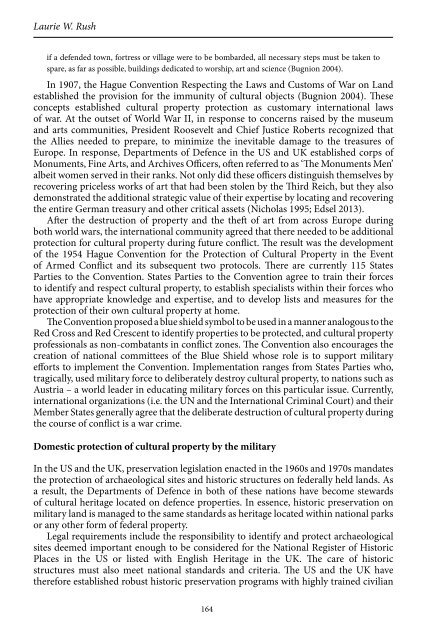Countering
Book_observatory_illicit_traffic_version%20issuu
Book_observatory_illicit_traffic_version%20issuu
You also want an ePaper? Increase the reach of your titles
YUMPU automatically turns print PDFs into web optimized ePapers that Google loves.
Military Protection of Cultural Property<br />
archaeologists, preservation architects, and other professionals on staff. The challenge<br />
these two countries have faced since 2001 has been to apply the rigorous heritage<br />
protection standards followed at home to operations abroad.<br />
Ministries of Defence and military organizations tend to take their own history very<br />
seriously and often establish departments of military history and military museums.<br />
One example is the preservation of Yugoslavian Leader Tito’s nuclear bunker in Konjic,<br />
Bosnia and Herzogovina. The nation’s military preserved the bunker and all of its<br />
furnishings completely intact and in operational order and turned it over to the Ministry<br />
of Culture in 2015.<br />
The protection of cultural property during military operations<br />
The looting of the Iraq National Museum in Baghdad in 2003 brought the implementation<br />
of the 1954 Hague Convention in the global media spotlight. In addition, when the<br />
international press reported damage by coalition forces assigned to protect the ancient<br />
site of Babylon, it became clear that military personnel assigned to protect archaeological<br />
sites lacked the necessary awareness, materials, and skills to minimize the impacts of<br />
their presence on the ruins for which they were responsible.<br />
Since then, the issues and challenges related to cultural property protection during the<br />
course of military operations have continued to increase in frequency and significance.<br />
Examples include the recovery of art and frescoes after the earthquake in Haiti, the<br />
successful implementation by NATO of a list for World Heritage sites in Libya, the<br />
destruction of Sufi tombs and evacuation of ancient manuscripts from Timbuktu, Mali,<br />
the measured response for recovery of collapsed sacred sites in Nepal, the deliberate<br />
destruction of archaeological sites and museum artifacts, and the massive scale looting by<br />
ISIS. These events evidence that primary stakes in modern conflict and disaster response<br />
increasingly revolve around heritage. Recent history and regional circumstances have<br />
resulted in tremendous variation in awareness, capability, capacity, and practices for<br />
cultural property protection by the responding military organizations.<br />
One way to develop a more nuanced understanding of cultural property protection<br />
during the course of modern military operations is to examine a range of variation in<br />
approach to the issue illustrated here by a series of Western military organizations.<br />
Austria<br />
The Austrian military demonstrates, to this day, tremendous commitment to the<br />
protection of cultural property, and is a world leader in this arena. In a presentation to<br />
an international conference held at the Hague in 2008, Karl Habsburg, Board member of<br />
Blue Shield International, mentioned that a contributing factor to the current Austrian<br />
emphasis on military protection of cultural property was the pro-active labeling of<br />
historic structures using the 1954 ‘Blue Shield’ Convention during the Cold War. Many<br />
Austrians credit the signs as a factor in discouraging aggressive maneuvers from the East<br />
crossing Austrian territory.<br />
The Austrians have also had positive experiences with prioritizing recovery during<br />
disaster response. During a World Archaeological Congress held in Vienna in 2008,<br />
BG Furstenhofer – who is now retired – described his experience of participating in<br />
an Austrian mission to assist the Italians after the 1980 Calabritto earthquake. BG<br />
Furstenhofer’s unit was working in a village where nearly every structure had been<br />
completely destroyed. Since all of the potential survivors had been rescued, the Austrians,<br />
165


